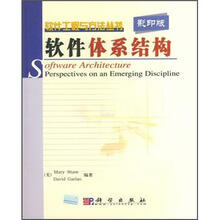软件体系结构(影印版)

目 录内容简介
chapter 1 introduction
1.1 what is software architecture?
1.1.1 software design levels
1.2 an engineering discipline for software
1.2.1 what is engineering?
1.2.2 the current state of software technology
1.3 the status of software architecture
1.4 the plan of this book
chapter 2 architectural styles
2.1 architectural styles
2.2 pipes and filters
2.3 data abstraction and object-oriented organization
2.4 event-based implicit invocation
2.5 layered systems
2.6 repositories
2.7 interpreters
2.8 process control
2.8.1 process-control paradigms
2.8.2 asoftware paradigm for process control
2.9 other familiar architectures
2.10 heterogeneous architectures
chapter 3 case studies
3.1 key word in context
3.1.1 solution 1: main program/subroutine with shared data
3.1.2 solution 2: abstract data types
3.1.3 solution 3: implicit invocation
3.1.4 solution 4: pipes and filters
3.1.5 comparisons
3.2 instrumentation software
3.2.1 an object-oriented model
3.2.2 a layered model
3.2.3 a pipe-and-filter model
3.2.4 a modified pipe-and-filter model
3.2.5 further specialization
3.2.6 summary
3.3 mobile robotics by marco schumacher
3.3.1 design considerations
3.3.2 solution 1: control loop
3.3.3 solution 2: layered architecture
3.3.4 solution 3: implicit invocation
3.3.5 solution 4: blackboard architecture
3.3.6 comparisons
3.4 cruise control
3.4.1 object view of cruise control
3.4.2 process-control view of cruise control
3.4.3 analysis and discussion
3.4.4 summary
3.5 three vignettes in mixed style
3.5.1 a layered design with different styles for the layers
3.5.2 an interpreter using different idioms for the components
3.5.3 a blackboard globally recast as an interpreter
chapter 4 shared information systems
4.1 shared information systems
4.2 database integration
4.2.1 batch sequential
4.2.2 simple repository
4.2.3 virtual repository
4.2.4 hierarchical layers
4.2.5 evolution of shared information systems in business data processing
4.3 integration in software development environments
4.3.1 batch sequential
4.3.2 transition from batch sequential to repository
4.3.3 repository
4.3.4 hierarchical layers
4.3.5 evolution of shared information systems in software development
environments
4.4 integration in the design of buildings
4.4.1 repository
4.4.2 intelligent control
4.4.3 evolution of shared information systems in building design
4.5 architectural structures for shared information systems
4.5.1 variants on datafiow systems
4.5.2 variants on repositories
4.6 some conclusions
chapter 5 architectural design guidance
5.1 guidance for user-interface architectures
by thomas g. lane
5.1.1 design spaces and rules
5.1.2 a design space for user-interface architectures
5.1.3 design rules for user-interface architecture
5.1.4 applying the design space: an example
5.1.5 avalidation experiment
5.1.6 how the design space was prepared
5.1.7 summary
5.2 the quantified design space
by toru asada roy lq. swonger nadine bounds and paul duerig
5.2.1 overview
5.2.2 background
5.2.3 quantified design space
5.2.4 conclusion
chapter 6 formal models and specifications
6.1 the value of architectural formalism
6.2 formalizing the architecture of a specific system
6.3 formalizing an architectural style
6.3.1 filters
6.3.2 pipes
6.3.3 pipe-and-filter system
6.4 formalizing an architectural design space
6.5 toward a theory of software architecture
6.6 what next?
6.7 z notation used in this chapter
chapter 7 linguistic issues
7.1 requirements for architecture-description languages
7.1.1 the linguistic character of architectural description
7.1.2 desiderata for architecture-description languages
7.1.3 problems with existing languages
7.2 first-class connectors
7.2.1 current practice
7.2.2 problems with current practice
7.2.3 a fresh view of software system composition
7.2.4 an architectural language with first-class connectors
7.2.5 the promise of explicit architectural notations
7.3 adding implicit invocation to traditional programming languages
7.3.1 introduction
7.3.2 adding implicit invocation to ada
7.3.3 evaluation
chapter8 tools for architectural design
8.1 unicon: a universal connector language
8.1.1 components and connectors
8.1.2 abstraction and encapsulation
8.1.3 types and type checking
8.1.4 accommodating analysis tools
8.2 exploiting style in architectural design environments
8.2.1 what is architectural style?
8.2.2 automated support for architectural design
8.2.3 observations about environments for architectural design
8.3 beyond definition/use:architecturalinterconnection
8.3.1 implementation versus interaction
8.3.2 example
8.3.3 the wright model of architectural description
8.3.4 reasoning about architectural descriptions
8.3.5 a brief explanation of our use of csp
chapter 9 education of software architects
9.1 philosophy and course overview
9.1.1 objectives
9.1.2 approach
9.2 course description
9.3 assignments
9.3.1 purpose
9.3.2 readings
9.3.3 architectural development tasks
9.3.4 formal modeling
9.3.5 analysis and interpretation of a system
9.4 evaluation
9.4.1 lessons from the initial offering
9.4.2 conclusions about teaching software architecture
bibliography
index
1.1 what is software architecture?
1.1.1 software design levels
1.2 an engineering discipline for software
1.2.1 what is engineering?
1.2.2 the current state of software technology
1.3 the status of software architecture
1.4 the plan of this book
chapter 2 architectural styles
2.1 architectural styles
2.2 pipes and filters
2.3 data abstraction and object-oriented organization
2.4 event-based implicit invocation
2.5 layered systems
2.6 repositories
2.7 interpreters
2.8 process control
2.8.1 process-control paradigms
2.8.2 asoftware paradigm for process control
2.9 other familiar architectures
2.10 heterogeneous architectures
chapter 3 case studies
3.1 key word in context
3.1.1 solution 1: main program/subroutine with shared data
3.1.2 solution 2: abstract data types
3.1.3 solution 3: implicit invocation
3.1.4 solution 4: pipes and filters
3.1.5 comparisons
3.2 instrumentation software
3.2.1 an object-oriented model
3.2.2 a layered model
3.2.3 a pipe-and-filter model
3.2.4 a modified pipe-and-filter model
3.2.5 further specialization
3.2.6 summary
3.3 mobile robotics by marco schumacher
3.3.1 design considerations
3.3.2 solution 1: control loop
3.3.3 solution 2: layered architecture
3.3.4 solution 3: implicit invocation
3.3.5 solution 4: blackboard architecture
3.3.6 comparisons
3.4 cruise control
3.4.1 object view of cruise control
3.4.2 process-control view of cruise control
3.4.3 analysis and discussion
3.4.4 summary
3.5 three vignettes in mixed style
3.5.1 a layered design with different styles for the layers
3.5.2 an interpreter using different idioms for the components
3.5.3 a blackboard globally recast as an interpreter
chapter 4 shared information systems
4.1 shared information systems
4.2 database integration
4.2.1 batch sequential
4.2.2 simple repository
4.2.3 virtual repository
4.2.4 hierarchical layers
4.2.5 evolution of shared information systems in business data processing
4.3 integration in software development environments
4.3.1 batch sequential
4.3.2 transition from batch sequential to repository
4.3.3 repository
4.3.4 hierarchical layers
4.3.5 evolution of shared information systems in software development
environments
4.4 integration in the design of buildings
4.4.1 repository
4.4.2 intelligent control
4.4.3 evolution of shared information systems in building design
4.5 architectural structures for shared information systems
4.5.1 variants on datafiow systems
4.5.2 variants on repositories
4.6 some conclusions
chapter 5 architectural design guidance
5.1 guidance for user-interface architectures
by thomas g. lane
5.1.1 design spaces and rules
5.1.2 a design space for user-interface architectures
5.1.3 design rules for user-interface architecture
5.1.4 applying the design space: an example
5.1.5 avalidation experiment
5.1.6 how the design space was prepared
5.1.7 summary
5.2 the quantified design space
by toru asada roy lq. swonger nadine bounds and paul duerig
5.2.1 overview
5.2.2 background
5.2.3 quantified design space
5.2.4 conclusion
chapter 6 formal models and specifications
6.1 the value of architectural formalism
6.2 formalizing the architecture of a specific system
6.3 formalizing an architectural style
6.3.1 filters
6.3.2 pipes
6.3.3 pipe-and-filter system
6.4 formalizing an architectural design space
6.5 toward a theory of software architecture
6.6 what next?
6.7 z notation used in this chapter
chapter 7 linguistic issues
7.1 requirements for architecture-description languages
7.1.1 the linguistic character of architectural description
7.1.2 desiderata for architecture-description languages
7.1.3 problems with existing languages
7.2 first-class connectors
7.2.1 current practice
7.2.2 problems with current practice
7.2.3 a fresh view of software system composition
7.2.4 an architectural language with first-class connectors
7.2.5 the promise of explicit architectural notations
7.3 adding implicit invocation to traditional programming languages
7.3.1 introduction
7.3.2 adding implicit invocation to ada
7.3.3 evaluation
chapter8 tools for architectural design
8.1 unicon: a universal connector language
8.1.1 components and connectors
8.1.2 abstraction and encapsulation
8.1.3 types and type checking
8.1.4 accommodating analysis tools
8.2 exploiting style in architectural design environments
8.2.1 what is architectural style?
8.2.2 automated support for architectural design
8.2.3 observations about environments for architectural design
8.3 beyond definition/use:architecturalinterconnection
8.3.1 implementation versus interaction
8.3.2 example
8.3.3 the wright model of architectural description
8.3.4 reasoning about architectural descriptions
8.3.5 a brief explanation of our use of csp
chapter 9 education of software architects
9.1 philosophy and course overview
9.1.1 objectives
9.1.2 approach
9.2 course description
9.3 assignments
9.3.1 purpose
9.3.2 readings
9.3.3 architectural development tasks
9.3.4 formal modeling
9.3.5 analysis and interpretation of a system
9.4 evaluation
9.4.1 lessons from the initial offering
9.4.2 conclusions about teaching software architecture
bibliography
index
目 录内容简介
《软件体系结构(影印版)》全面讨论了软件体系结构研究的由来和发展,介绍了有关体系结构概念的构成和关于体系结构的不同观点,并给出了描述体系结构的有关理论和方法的研究成果。在此基础上指出了体系结构的多层次概念,并就各个层次的构成通过举例进行了全面的说明。体系结构的举例都是来自现实常用和通用的软件技术和应用。通过《软件体系结构(影印版)》的阅读,读者将对体系结构概念和知识有一个全面而实际的认识。
《软件体系结构(影印版)》面向软件专业的大学高年级学生、研究生、从事软件工作的工程技术人员,以及对软件体系结构研究和应用感兴趣的读者。
《软件体系结构(影印版)》面向软件专业的大学高年级学生、研究生、从事软件工作的工程技术人员,以及对软件体系结构研究和应用感兴趣的读者。
比价列表
公众号、微信群
 缺书网
缺书网微信公众号
 扫码进群
扫码进群实时获取购书优惠





